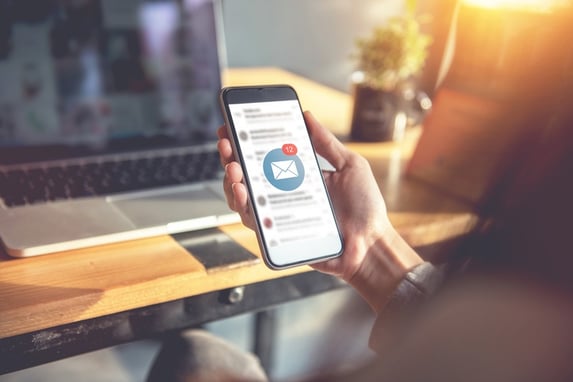There is no shortage of blogs about best practices for email subject lines. However, today’s post is specific to email subject lines for agency new business. What’s the difference? For starters, a good deal of the best practice tips that are out there may work well for B2C email but would be inappropriate in the agency new business context. I’ve dug through a ton of previously published posts on email subject lines and compiled only what is useful for agencies to use in their new business efforts.

Why worry about your subject line?
Your subject line largely determines whether your email will make it to your recipient’s inbox or their SPAM box, whether it will be marked as SPAM by the recipient (hurting your future outreach efforts), or opened. A good email open rate is an indication you are doing something right with your email subject line, while a low open rate indicates the opposite.
Hubspot compiled some industry statistics on email subject lines that may help illuminate the importance of this often-overlooked aspect of your email outreach.
They include:
- 69% of email recipients report email as spam based solely on the subject line [Source: Convince&Convert]
- 33% of email recipients open email based on subject line alone. [Source: Convince&Convert]
A few things to know before we get into the best practices:
ONE: Email subject line effectiveness is most commonly measured by your email open rate (higher open rates indicate a good subject line; lower open rates indicate an ineffective subject line). However, email open rates aren’t an exact science. Sometimes opened emails aren’t counted (MailChimp), and sometimes opens are counted when people are just going through their inbox deleting emails, and the next email opens automatically. In that case, the open won’t indicate interest or intent, which is generally the default assumption.

TWO: There is a lot of conflicting data out there. Some studies say using a certain word will boost your email open rates, while others say the same word reduces open rates. Take everything with a grain of salt, and constantly test your emails to discover performance trends for your email lists. Studies can give you clues and ideas, but ultimately it comes down to what works best for you.
THREE: Speaking of taking things with a grain of salt…One thing I noticed when reviewing existing content on email subject lines is that A/B tests are presented with incomplete information, making it impossible to determine if the comparison is apples-to-apples. For example, if two emails with different subject lines were sent at different times on different days of the week, or if they were sent to different lists, or if they were sent to the same list at very different stages (first email to the list vs. 14th email to the list), you could expect very different open rates for reasons other than the subject line.
If someone sends an email to a list of 5,000 and another to a list of the 300 most engaged list members, the open rates are not comparable. That’s why in their Subject Line Data post, MailChimp advises only considering campaigns sent to 500 or more recipients and sent by users who have sent 10 or more campaigns before. Before you run off to emulate a “top-performing” email subject line from a published A/B test, consider how your recipients will likely respond to it. And watch your results closely.

FOUR: Personalization in email subject lines continues to be a frequently-cited way to boost your open rates. While research indicates a significant difference on the influence of subject line personalization by industry, according to MailChimp’s data, creative services/agencies have the second-highest rate of impact for first name personalization in the subject line, at 0.45. That means this strategy is ripe for you to test.
What is less frequently discussed is the issue of data cleanliness in personalization. Poor data hygiene has the potential to counteract any gains in engagement. To be effective, your data has to be very clean; cleaner that many businesses tend to keep them. Don’t believe me? Do an export of your send-to list and check it for phonetic spellings, off-standard capitalization, typos, missing fields, etc. The most important fields for personalization are typically [first name], [last name], and [company name].
If you haven’t checked your contact data in over a year, you should probably assume your data is not ready to be prospect-facing. So don’t forget to address that before you start using subject line personalization, and calendar to revisit it on an ongoing basis.
Tips that are most relevant to agency new business:
Be concise.
INSIGHT: This applies to both the subject line and the body of the email. We often have email copy provided by someone who is very passionate and emotionally invested in selling an agency’s services. What they think is imperative to include in an initial cold email tends to be more than we might agree with, from a more removed, objective perspective. Keep in mind that the more you cut, the more the remaining copy can be digested by the recipient. Less is more. Topically, everything must be tightly relevant to your one key point, no extraneous sentences about other things your agency does well, etc. Consider the one key thing you want recipients to know, be clear about it, and be sure that everything in the email works to support that point.
Watch the length (40-50 characters; 4-7 words).
INSIGHT: Constant Contact says to cap your subject line at 40 characters, Hubspot says 50. CoSchedule suggests as few as 30. This is because a significant portion (about 40%, according to ContactMonkey) of your recipients are likely to view your email on mobile, where long subject lines will be more challenging to view.
How much weight should you give this suggestion? MailChimp says, “For most users, there is no statistical link between subject line length and open rate. But for subscribers reading your campaigns on mobile devices, shorter may be better.” So use your discretion. You can preview and test your subject line display on mobile devices for free on sites like Zurb Studios and EmailToolTester.com.

Be aware of SPAM-trap keywords.
INSIGHT: Certain words will get your email flagged as SPAM by the ESPs before it even has a chance to reach your recipient. Worse, being flagged as SPAM can hurt your future email deliverability. So, be sure to avoid all caps and multiple exclamation points, and review lists like these that round up the words that are likely to get your email flagged as SPAM when included in your email subject line.
Curious about which keywords perform best in email subject lines? OptInMonster’s post includes data from Alchemy Worx, which has analyzed billions of emails sent by thousands of brands for the most effective subject line keywords.
Understand the psychological principles underlying user engagement.
INSIGHT: Psychology weighs heavy on articles about subject line performance. They boil down to the same set of concepts. Many of them are challenging to apply to the agency new business context because they present as too casual or unprofessional. However, here are a few that you may be able to apply to agency new business outreach:
- Fear of missing out (sometimes referred to as urgency, scarcity)
- Curiosity (“Why does [your competitor] get better results from their agencies than [your brand]?”)
- Pain points (“Tired of not being able to trust your agency partner?”)
- Personalization (“Kirsten, you know you want to upgrade your brand graphics”)
More subject line ideas to test:
- Incorporate numbers
- Use action verbs
- Avoid all caps (SERIOUSLY THOUGH, NEVER DO THIS!!!)
- Avoid multiple exclamation points
- Avoid typos
- Avoid a ton of emojis (perhaps avoid them altogether, but if you do incorporate them, do so sparingly and thoughtfully)
- Pose a question
- Be direct
- Be descriptive
- Be honest (remember, you are trying to build a new relationship, not just get a click)
- A clear, compelling value proposition that is consistent with the body of your email
- Be creative (you don’t want the same tired subject line as everyone else)
- Test using all lowercase, sentence case, and All Words Capped for your subject line
If you want to test your email subject line, CoSchedule has a new tool that may be useful; try it here.
Keep in mind that many email subject line trends (like using emojis, or creating a sense of urgency) have been proven effective, but are challenging, if not inappropriate to use in the agency new business context. There may be times here and there when you can find a sensible way to leverage those strategies, but they are probably not going to be the norm.
I hope this gives you some new ideas to apply to your agency new business program. We’ll be back next week with a follow-up post on email opening lines, so stay tuned for that.
Are you subscribed yet?
You may also want to read:
- 6 Practical Reasons Why Your Agency Needs a Sales Process
- When Summer Interns are Tasked with New Business
- How to Use Personality Types to Improve Agency Sales
Image credits: email lead generation for agency new business © iStockphoto.com/NicoElNino; avoid spam traps © iStockphoto.com/Marco_Piunti; email inbox agency new business © iStockphoto.com/Rawpixel; agency new business emails on mobile devices ©iStockphoto.com/oatawa



